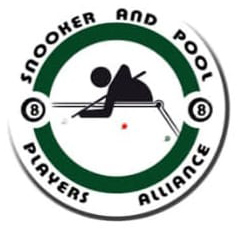Rules of Play for Cue Sports
The rules of play ratified by the Cue Sports Association of Nigeria rules for billiards, Pool and snooker apply.
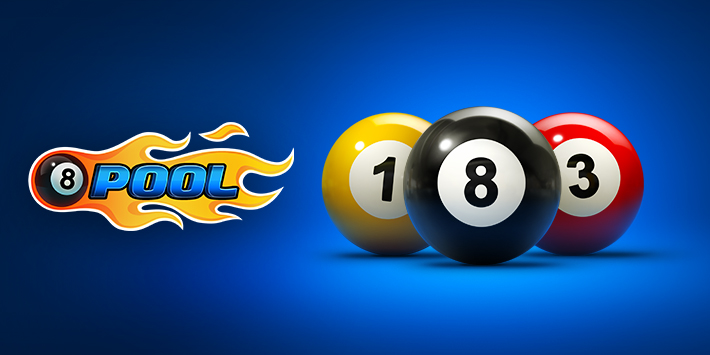
8 BALL
OBJECT OF THE GAME – Eight Ball is a call shot game played with a cue ball and fifteen object balls, numbered 1 through 15. One player must pocket balls of the group numbered 1 through 7 (solid colors), while the other player has 9 thru 15 (stripes). THE PLAYER POCKETING HIS GROUP FIRST AND THEN LEGALLY POCKETING THE 8-BALL WINS THE GAME.
CALL SHOT – In Call Shot, obvious balls and pockets do not have to be indicated. It is the opponent’s right to ask which ball and pocket if he is unsure of the shot. Bank shots and combination shots are not considered obvious, and care should be taken in calling both the object ball and the intended pocket. When calling the shot, it is NEVER necessary to indicate details such as the number of cushions, banks, kisses, caroms, etc.
Any balls pocketed on a foul remain pocketed, regardless of whether they belong to the shooter or the opponent. The opening break is not a “called shot.” Any player performing a break shot in 8-Ball may continue to shoot his next shot so long as he has legally pocketed any object ball on the break.
RACKING THE BALLS – The balls are racked in a triangle at the foot of the table with the 8-ball in the center of the triangle, the first ball of the rack on the footspot, a stripe ball in one corner of the rack and a solid ball in the other corner.
ALTERNATING BREAK – Winner of the lag has the option to break. During individual competition, players will alternate breaking on each subsequent game.
JUMP AND MASSE SHOT FOUL – While “cue ball fouls only” is the rule of play when a match is not presided over by a referee, a player should be aware that it will be considered a cue ball foul if during an attempt to jump, curve or masse the cue ball over or around an impeding numbered ball that is not a legal object ball, the impeding ball moves (regardless of whether it was moved by a hand, cue stick follow-through or bridge).
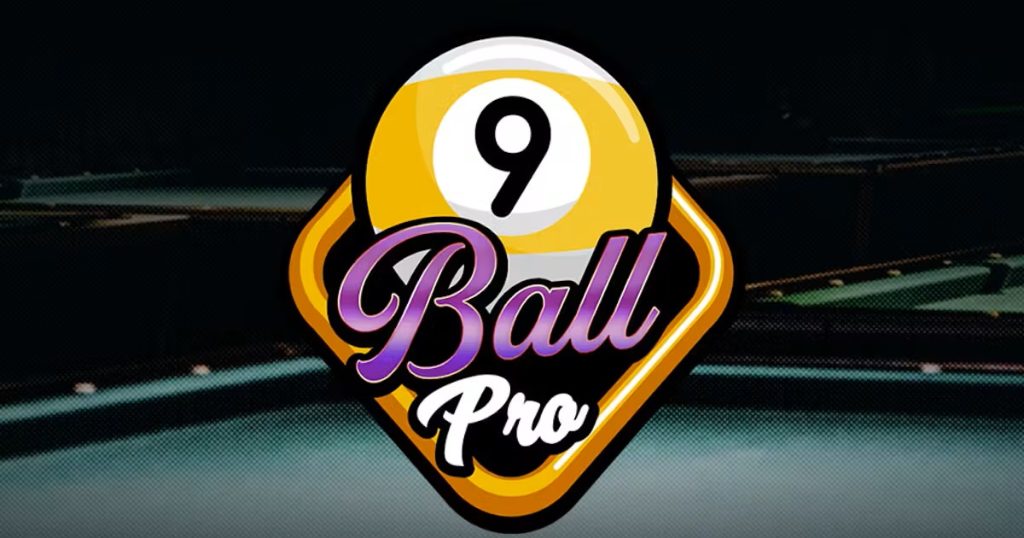
9 BALL POOL
OBJECT OF THE GAME – Nine Ball is played with nine object balls numbered one through nine and a cue ball. On each shot the first ball the cue ball contacts must be the lowest-numbered ball on the table, but the balls need not be pocketed in order. If a player pockets any ball on a legal shot, he remains at the table for another shot, and continues until he misses, fouls, or wins the game by pocketing the 9-ball. After a miss, the incoming player must shoot from the position left by the previous player, but after any foul the incoming player may place the cue ball anywhere on the table. Players are not required to call any shot.
RACKING THE BALLS – The object balls are racked in a diamond shape, with the one ball at the top of the diamond and on the foot spot, the nine ball in the center of the diamond, and the other balls in random order, racked as tightly as possible. The game begins with cue ball in hand behind the headstring.
START OF PLAY – The home team breaks first and writes their line-up down first. The break alternates thereafter. A game starts as soon as the cue ball crosses over the headstring on the opening break.
LEGAL BREAK SHOT – The rules governing the break shot are the same as for other shots except:
- The breaker must strike the 1-ball first and either pocket a ball or drive at least four numbered balls to a rail, failure to do so is a foul. Incoming player accepts table the way it lies with ball in hand or requests a re-rack with cue ball behind the headstring.
- If the cue ball is pocketed or driven off the table, or the requirements of the opening break are not met, it is a foul, and the incoming player has cue ball in hand anywhere on the table.
- If on the break shot, the breaker causes an object ball to jump off the table, it is a foul and the incoming player has cue ball in hand anywhere on the table. The object ball is not re-spotted.
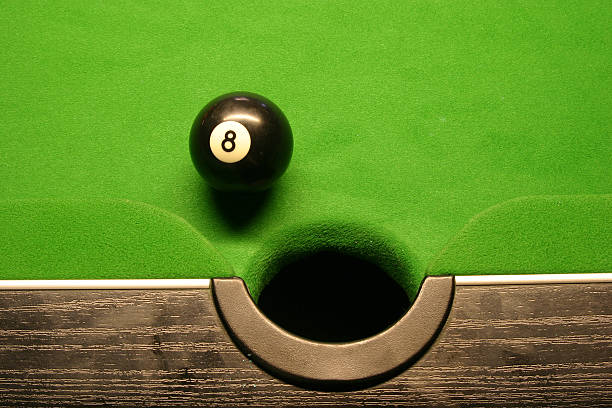
BLACK BALL POOL
Black ball is played with 15 colored object balls and the cue ball. The object balls are two groups of seven and the black ball. The player or team pocketing their group of object balls and legally pocketing the black ball wins the game. Shots are not called.
Definitions
The following definitions apply to black ball:
Free shot
After a foul has been committed the incoming player is awarded a free shot. On a free shot Rule Wrong Ball First is suspended and the player may take the cue ball in position or in hand in baulk.
Baulk
Baulk is the rectangular area of the table that is bordered by the baulk line and the three cushions at the head of the table. The baulk line is parallel to the head rail and one fifth of the length of the playing surface away from the head cushion. For the applicable general rules, “behind the head string” should be read as “in baulk.”
Snookered
A player is said to be snookered when the cue ball has no straight, direct path to hit at least part of a legal target ball. The snooker must be declared by the referee for it to be in effect.
Ball On
An object ball is said to be “on” when it is a legal target for the shooter.
Equipment
The fifteen object balls include two groups of seven balls distinguished by two solid colors or by the usual pattern of numbered solids and stripes. (One through seven and nine through fifteen are the two groups.) In addition, there is a black ball or a black eight ball.
#Blackball
The foot spot and the baulk line should be marked.
Determining First Break
The player winning the lag has the option to determine who has to execute the first break shot. (See 1.2 Lagging to Determine Order of Play ) The standard format is alternate break (see Regulations).
Black Ball Rack
The balls are racked as illustrated with the black ball on the foot spot.
Break Shot
The following rules apply to the break shot.’
- The cue ball begins in hand in baulk.
- At least one ball must be pocketed or at least two object balls must cross the center string or the break shot is a foul.
- If the black ball is pocketed on the break, all the balls are re-racked and the same player breaks again.
- Any violation of Cue Ball Scratch or off the Table or Ball Driven off the Table is ignored on a break that pockets the black ball.
Open Table / Choosing Groups
The table is said to be “open” when the players’ groups have not been decided. The table is open after the break shot and remains open until the shooter pockets balls from only one group on a legal normal shot, which means not a break shot and not a free shot. The shooter is then assigned that group of balls to pocket and the opponent is assigned the other group.
Continuing Play
The shooter remains at the table as long as he continues to legally pocket balls or the rack ends. If he fails to legally pocket a ball but commits no foul, the opponent shoots from the position left.
Cue Ball in Hand in Baulk
When the player has the cue ball in hand, he may place it by hand anywhere in baulk. The player may continue to adjust the position of the cue ball by hand until he takes a shot. The cue ball is not required to leave baulk before striking an object ball.
Touching Balls
If the cue ball is touching an object ball, the shooter must not play the cue ball in the direction of that ball. He is considered to have hit the touching ball when he shoots away from it if the ball is on for the shot.
Playing from a Snooker
When the shooter is snookered, Rule 6.3 No Rail after Contact is suspended for the shot.
Spotting Balls
Object balls driven off the table are spotted on the long string. If several balls are to be spotted, they are spotted in the following order: (1) the black ball, (2) balls from the group of the next shooter, or balls from the red, blue or solid group if the table is open, (3) other balls.
Stalemate
In case of a stalemate due to lack of progress towards a conclusion, the breaker of the rack will break again. A stalemate also occurs if the position does not allow any legal shot.
Standard Fouls
If the shooter commits a foul, play passes to his opponent. The incoming player has one free shot (see Free shot) as the first shot of his inning.
The following are standard fouls at black ball:
- Cue Ball Scratch or off the Table
- Wrong Ball First (suspended for a free shot)
- No Rail after Contact
- No Foot on Floor
- Ball Driven off the Table
- Touched Ball
- Double Hit / Frozen Balls
- Push Shot
- Balls Still Moving
- Bad Cue Ball Placement (when playing from baulk)
- Cue Stick on the Table
- Playing out of Turn
- Slow Play
The following additional situations are fouls at black ball.
- Pocketing Opponent’s Ball
- It is a foul to pocket an opponent’s ball without also pocketing a ball from your own group.
- Table Incorrect – It is a foul to play before all balls that require spotting have been spotted.
- Jump Shot – Causing the cue ball to jump over any ball is a foul. (If the cue ball leaves the bed of the table and misses an object ball that would have been struck had the cue ball not left the table on an otherwise identical shot, the cue ball is deemed to have jumped over that object ball.)
Loss of Rack Fouls
The player loses the rack if he:
- Pockets the black ball on an illegal shot;
- pockets the black ball on a shot that leaves any of his group of balls on the table;
- intentionally violates 6.2 Wrong Ball First; or
- does not attempt to hit a ball on.
- Unsportsmanlike Conduct will be penalized by loss of rack or other penalty depending on the nature of the conduct.
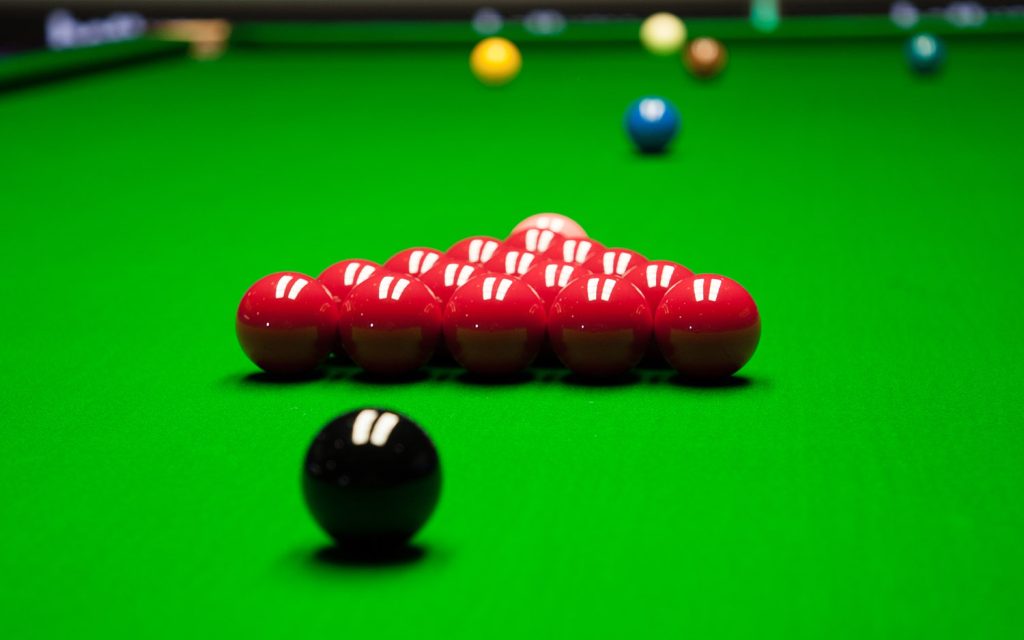
SNOOKER
Snooker is one of the world’s most popular games due to its growth in India and China but, for now, it remains largely dominated by British players at the highest level. The Snooker World Championship is – for many – one of the biggest sporting events of the year but the sport is also played in clubs, and sometimes pubs, all over the UK by amateurs of all levels.
It developed from another cue sport, billiards, which began in the 16th century, with snooker coming along in the late 19th century. The first official snooker tournament was in 1916 with the first World Championship appearing in 1927 and since then the popularity of the game has ebbed and flowed, with the 1970s and 1980s probably the game’s finest era.
OBJECT OF THE GAME – The object of the game is to use the white cue ball to pot the other balls in the correct sequence and ultimately score more points than your opponent in order to win the frame, a frame being the individual game unit.
PLAYERS & EQUIPMENT – Snooker is played one against one and the size of the balls and table are regulated. The table is rectangular, measuring 12ft x 6ft and just under 3ft in height, and usually made of wood with a slate top covered in green baize. The table has six pockets into which the balls are potted, one in each corner and two in the middle of the long sides, or cushions. The end from which the game starts is called the baulk end and has a line across the width of the table 29 inches from the baulk cushion. In the centre of this is the D, an 11.5 inch-radius semi-circle with the baulk line as its diameter.
The hard balls, made from phenolic resin, are approximately 2.7 inches in diameter (they are given in metric units of 52.5mm). There are 15 red balls and one each of black, pink, blue, brown, green and yellow, as well as a white cue ball which is the only one struck by the players. The colours go on their spots, the green, brown and yellow from left to right on the baulk line across the semi-circle. The blue goes in the middle of the table, the pink midway between there and the top cushion (the opposite end to the baulk cushion) with the black in the centre, 12¾ inches off the top cushion. The 15 reds are placed in a triangle with one red at the point behind the pink.
The players use a cue, usually made of wood, to strike the white ball and this must be “not less than 3ft in length and shall show no substantial departure from the traditionally and generally accepted shape and form”.
SCORING – Players score one point for potting a red, after which they must nominate a colour for their next shot. The black is worth seven and is the most valuable going down through pink (six), blue (five), brown (four), green (three) and yellow (two). After each colour (the six colours are re-spotted but the reds are not) the player reverts to a red and alternates red, then colour until all the reds are potted. The remaining six colours are then potted in ascending points order, thus finishing with the black.
A player continues until he misses a ball or commits a foul, the players alternating turns. The maximum standard break (the term given to a consecutive run of pots) is 147 (15 reds taken with 15 blacks and then all the colours).
If a player commits a foul their opponent is awarded four points, unless the foul occurred whilst playing the blue, pink or black or hit one of those higher values first, in which case the foul is worth the value of the ball in question.
WINNING THE GAME – The winner is the person who scores the most points in a frame. Once a player has a lead of more points than remain on the table the opponent is said to “need snookers”. A snooker is where the balls are so placed so that the player cannot directly hit the next legal ball. The hope is to force a foul and earn four points. If a player thinks they cannot win, even by forcing snookers, they concede the frame, usually when around four or more snookers (fouls) would be required in addition to all the remaining balls, depending on how many balls are left.
A match is normally played “best of” a set number of frames, ranging from three right up to 35 for modern World Championship finals, such that the winner would be the first player to reach an unassailable lead.
Rules of Snooker
Players take it in turns to break (start the frame) with a coin toss deciding who starts the first frame. The break is made with the cue-ball in the D and a red must be struck. If both players agree a frame can be restarted, if, for example, both players agree the balls are so placed that the frame could lead to a stalemate.
A push shot, which is a foul, is when the tip of the cue remains in contact with the cue-ball as it in turn touches the target ball. The cue ball must only be played with one clean strike of the cue.
The referee may call a miss if the player does not strike the correct ball and is adjudged not to have made a serious attempt to. The other player is awarded the foul (four or more) and has the option to make the player replay the shot.
All balls must be stationary before the next shot is played.
The cue ball must hit the nominated ball first, or if it is a red, any red. Failure to do so is a foul, as is not hitting any ball or potting a non-nominated ball.
If the player touches any ball with any part of their body or any ball other than the white with their cue it is a foul.
Hitting a ball off the table is a foul. Reds are not replaced but colours will be re-spotted.
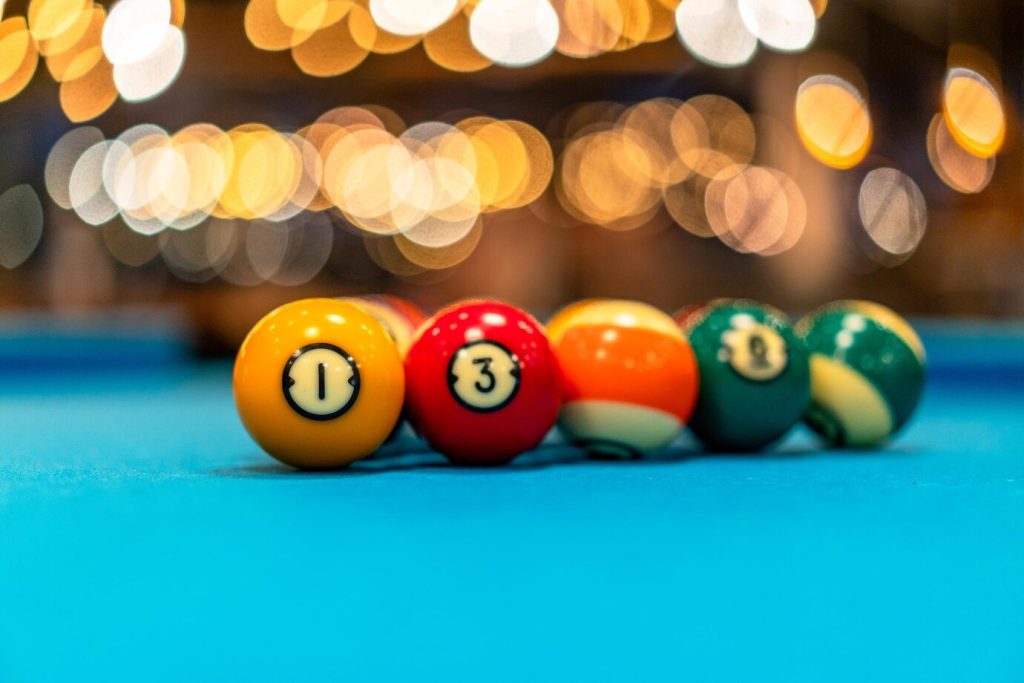
World Chinese Pool Masters
1. Player’s Obligations
It’s players’ obligation to be in the know with all the rules and regulations of the game. Should there be any changes to the rules and regulations, the Organizing Committee should deliver the latest changes timely.
2. Method of Play
Chinese 8-ball game is played with 15 object balls from No.1 to No.15 and the cue ball. If one player chooses No.1 to No.7 (solids) then the other player must choose No.9 to No.15 (stripes), and vice versa. The shooter remains at the table as long as he continues to legally pocket his group of balls, and he wins the rack by pocketing the 8 ball.
3. Equipment
(a) Table: Internal edge size is 2540 x 1260mm(+/-9mm) height from the ground to the cushion top is 800mm-850mm.
(b) Cue: No less than 101.6cm. The material and shape must be up to the standard of International Chinese 8-Ball Association.
(c) Balls: Diameter 57.15mm(+/-0.05mm), Weight 156g-170g.
(d) Foot spot: 635 mm from the top cushion on longitudinal centre line.
(e) Head string: 450mm from the bottom cushion and parallel to the bottom cushion.
(f) Break area: Between the top cushion and the head string.
4. Racking Balls
Object balls should be racked as tightly as possible in a triangle, with the apex ball on the foot spot and the 8 ball at the centre of the triangle. A solid ball and a stripe ball should be placed on the two lower corners of the triangle. Other solids and stripes should be separated as far as possible, but being racked as tightly as possible.
Players can check if the balls are placed right and tightly, and both can ask for referee’s adjustment. (This could be reappointed by the organizing committee before the game).
- Lagging For the Break
The lag is the first shot of the match and determines order of play.
The player who wins the lag chooses who will shoot first.
The referee will place a ball on each side of the table behind the head
string and near the head string. After the referee’s call, the players
will shoot at about the same time to make each ball contact the foot
cushion with the goal of returning the ball closer to the head cushion
than the opponent.
A lag shot is bad and cannot win if the shooter’s ball:
(a) crosses the long string;
(b) contacts the foot cushion other than once;
(c) is pocketed or driven off the table;
(d) touches the side cushion; or
(e) the ball rests within the corner pocket and past the nose of the
head cushion.
The players will lag again if:
(a) a player’s ball is struck after the other ball has touched the foot
cushion;
(b) the referee cannot determine which ball has stopped closer to the
head cushion; or(c) both lags are bad.
- Break shot
The following rules apply to the break shot:
(a) The cue ball begins in hand behind the head string.
(b) No ball is called, and the cue ball is not required to hit any
particular object ball first.
(c) A male player’s break shot should meet the minimum
requirement of “head string being crossed 4 times by numbered
balls”, which means:
(1) the head string is crossed (more than half or half of a ball) 4
times by numbered ball or balls (the cue ball is not included); or
(2) one ball is pocketed and the head string is crossed 3 times; or
(3) two balls are pocketed and the head string is crossed twice; or
(4) three balls are pocketed and the head string is crossed once; or
(5) four or more object balls are pocketed.
* If a ball crosses the head string and then gets pocketed, it is
regarded as having crossed the head string TWICE.
Female players and the players who are under 14 years of age
should meet the minimum requirement of “head string being crossed
3 times”.
If the break shot fails to meet this minimum requirement, the
situation is regarded as a “loss of chance”, and the incoming player
has the option of:
(1) accepting the table in position, or(2) re-racking and breaking, or
(3) re-racking and allowing the offending player to break again.
Three accumulated “loss of chances” will be considered as
losing the ongoing rack.
(d) Soft breaks are not allowed – In the situation that less than four
object balls is driven to one or more rails, the shot will be seen as an
intentional attempt to slow down the game (It will NOT be regarded
as a loss of chance nor an illegal break), and will result in the loss of
the ongoing rack.
(e) Pocketing the eight ball on a legal break shot is not a foul. If the
eight ball is pocketed, the breaker has the option of (1) re-spotting the
eight ball and accepting the balls in position, or (2) re-breaking.
(f) If the breaker pockets the eight ball and scratches, it is a foul; the
opponent has the option of (1)re-spotting the eight ball and shooting
with cue ball in hand behind the head string; or(2) re-breaking.
(g) If any object ball is driven off the table on a break shot, it is a foul;
such balls remain out of play (except the eight ball which is
re-spotted); and the incoming player has the option of (1) accepting
the table in position, or (2) taking cue ball in hand behind the head
string.
- Restoring a Position
When necessary for balls to be restored or cleaned, the referee will
restore disturbed balls to their original positions to the best of his
ability. The players must accept the referee’s judgment as to
placement.
- Cue Ball in Hand Behind the Head String
When the breaker fouls, the opponents gets ball in hand behind the
head string. When the cue ball is in hand behind the head string, and
the first ball the cue ball contacts is also behind the head string, the
shot is a foul unless the cue ball crosses the head string before that
contact. The cue ball must either cross the head string or contact aball in front of or on the head string or the shot is a foul, and the cue
ball is in hand for the following player.
When the shooter has the cue ball in hand behind the head string and
all the legal object balls are behind the head string, he may request
the legal object ball nearest the head string to be spotted. If two or
more balls are equal distance from the head string, the shooter may
designate which of the equidistant balls is to be spotted. An object
ball that rests exactly on the head string is playable.
- Cue Ball in Hand
When the cue ball is in hand, the shooter may place the cue ball
anywhere on the playing surface and may continue to move the cue
ball until he executes a shot. Players may use any part of the cue stick
to move the cue ball, including the tip, but not with a forward stroke
motion. For break shots, placement of the cue ball is restricted to the
area behind the head string.
- Open Table
The open table means the ownership of the solid balls or stripe balls
were not decided. Before groups are determined, the table is said to
be “open”, If the shooter legally pockets his ball, the corresponding
group becomes his, and his opponent is assigned the other group. If
he fails to legally pocket his ball, the table remains open and play
passes to the other player. When the table is “open”, any object ball
may be struck first except the eight ball.
Under the rare circumstances that all solids (or stripes) are pocketed
after the break shot, it is regarded as an open table; two players can
only play for the remaining group, and when the ownership of the
group is confirmed, the table is closed.
- Call Your Shot – No Need
There is NO NEED to call your shot / designate a pocket, even for the
8 ball or the shootout. Flukes are allowed.Attention: The shooter may NO LONGER call “safety” in which case
play passes to the opponent at the end of the shot and any object ball
pocketed on the safety remains pocketed.
- When shooting
12.1 Determining Groups
Before groups are determined, the table is said to be “open”, if the
shooter legally pockets the first-hit ball or ball(s) of the same group as
the first-hit ball, then the table is closed, and the selected group
becomes his group. The shooter remains at the table as long as he
continues to legally pocket his group of balls, and he wins the rack by
pocketing the 8 ball.
12.2 If no ball is pocketed on a shot, the cue ball must contact an
object ball, and after that contact at least one ball (cue ball or any
object ball) must be driven to a rail, or the shot is a foul.
12.3 After a shot, the cue ball and the balls not pocketed must be on
the table.
12.4 It is a foul to touch, move or change the path of any object ball
except by the normal ball-to-ball contacts during shots. It is a foul to
touch, move or change the path of the cue ball except when it is in
hand or by the normal tip-to-ball forward stroke contact of a shot.
The shooter is responsible for the equipment he controls at the table,
such as chalk, bridges, clothing, his hair, parts of his body, and the
cue ball when it is in hand, that may be involved in such fouls.
12.5 Double hit
If the cue stick contacts the cue ball more than once on a shot, the
shot is a foul. If the cue ball is close to but not touching an object ball
and the cue tip is still on the cue ball when the cue ball contacts that
object ball, the shot is a foul. If the cue ball is very close to an object
ball, and the shooter barely grazes that object ball on the shot, the
shot is assumed not to violate the rule, even though the tip is arguably
still on the cue ball when ball-ball contact is made.
12.6 Push shotIt is a foul to prolong tip-to-cue-ball contact beyond that seen in
normal shots. In other words, the hitting action between the tip and
cue ball should be a momentary hit, not a push.
12.7 All the foul behaviors should be judged before the next hitting, or
will be treated as no foul happens.
- Cue Ball Contacting Legal & Illegal Balls Simultaneously
After a stroke, if the cue ball cause both the legal and illegal balls to
move at almost the same time, and the referee can not judge which
ball was first touched, then it will be considered the legal ball being
touched first.
- Balls Settling
A ball may settle slightly after it appears to have stopped, possibly
due to slight imperfections in the ball or the table. Unless this causes
a ball to fall into a pocket, it is considered a normal hazard of play,
and the ball will not be moved back. If a ball falls into a pocket as the
result of such settling, it is restored as closely as possible to its
original position. If a settling ball falls into a pocket during or just
prior to a shot, and this has an effect on the shot, the referee will
restore the position and the shot will be replayed. The shooter is not
penalized for shooting while a ball is settling.
- Frozen Balls
15.1 If the cue ball is touching an object ball at the start of the shot, it
is legal to shoot towards or partly into that ball (provided it is a legal
target) and if the object ball is moved by such a shot, it is considered
to have been contacted by the cue ball. Playing away from a frozen
ball does not constitute having hit that ball.
15.2 When the object ball is frozen to the rail, then it’s a legal shot if
only:
(a) after the cue ball contacts the object ball, the object ball hits a
second rail, or
(b) there are other balls contacting the rails, or(c) a ball or more balls are pocketed.
Violation will result in a foul.
- Jump Shot
A jump shot is one in which the cue ball is made to go over an
intervening obstacle such as an object ball or part of the cushion.
Whether such a shot is legal depends on how it is accomplished and
the intention of the shooter. Usually a legal jump shot is played by
elevating the cue stick, hitting the upper half of the cue ball and
driving the cue ball down into the playing surface from which it
rebounds.
- Fouls
If the shooter commits a foul, the opponent gets a cue ball in
hand.The following are standard fouls in Chinese 8-ball:
(a) The cue ball is scratched or off the table;
(b) The cue ball hit wrong group of balls first;
(c) Begin a shot while any ball in play is moving or spinning;
(d) The shooter does not have at least one foot touching the floor at
the instant the tip contacts the cue ball;
(e) The object ball is driven off the table;
(f) Touch the balls illegally;
(g) Double hit;
(h) Push shot – It is a foul to prolong tip-to-cue-ball contact beyond
that seen in normal shots;
(i) Bad play from behind the head string.18. Intentional Fouls
It is an INTENTIONAL foul for the cue ball to first contact the other
group of balls on purpose / deliberately. Intentional fouls are
regarded as a serious foul. A player’s first intentional foul will be
judged as losing a rack, and his second intentional foul will result in
losing the whole match.
- Ball Group Confusion
After the table is closed, if a player wrongly hits the other group balls,
the foul must be pronounced before his next shot. When any player or
a referee realizes that the groups are wrongly played, the rack should
stop at once, and re-rack.
- Loss of rack
The shooter loses if he/she:(a) pockets the 8 ball and fouls;
(b) pocket the 8 ball on his last shot before the 8 ball;
(c) drives the 8 ball off the table;
(d) pocket the 8 ball before his group is cleared;As long as the 8 ball
stays on the table, there can only be fouls.
However, if the 8 ball is driven off the table, it will be loss of rack.
- Stalemate
If the referee observes that no progress is being made towards a
conclusion, he will announce his decision, and each player will have
three more turns at the table. Then, if the referee determines that
there is still no progress, he will declare a stalemate. If both players
agree, they may accept the stalemate without taking their three
additional turns. If a stalemate occurs, the original breaker will break
again.
- Outside InterferenceWhen outside interference occurs during a shot that has an effect on
the outcome of that shot, the referee will restore the balls to the
positions they had before the shot, and the shot will be replayed. If
the interference had no effect on the shot, the referee will restore the
disturbed balls and play will continue. If the balls cannot be restored
to their original positions, the situation is handled like a stalemate.
- Abstention
Players can make voluntary abstention only in his turn. Abstention
could be designed to a rack or the game.
- Unsportsmanlike Conduct
The normal penalty for unsportsmanlike conduct is the same as for a
serious foul, but the referee may impose a penalty depending on his
judgment of the conduct. Among other penalties possible are a
warning; a standard-foul penalty; a serious-foul penalty; loss of a
rack, set or match; ejection from the competition possibly with
forfeiture of all prizes, trophies and standings points.
Unsportsmanlike conduct is any intentional behavior that brings
disrepute to the sport or which disrupts or changes the game to the
extent that it cannot be played fairly. It includes
(a) distracting the opponent;
(b) changing the position of the balls in play other than by a shot;
(c) playing a shot by intentionally miscuing;
(d) continuing to play after a foul has been called or play has been
suspended;
(e) practicing during a match;
(f) marking the table;
(g) delay of the game;(h) using equipment inappropriately; and
(i) the player admits defeat before his opponent finishes the rack.
The Organizing Committee owns the right of final interpretation of
this rule.This version of the rules referred to the WPA Rules of
American 8-ball, 9-ball, 10-ball and the draft rules of CBSA, sought
the opinions from professionals and amateurs, pool halls owners,
tournament operators, referees and fans. The purpose is to improve
the game’s fairness, fluency and ornamental values, and to help the
game integrate into the global community. We will continue to
perfect the rules with the development of this sport. We wish to
receive suggestions, understanding and support from everyone.
WORLD CHINESE 8-BALL MASTERS
RULES AND REGULATIONS
